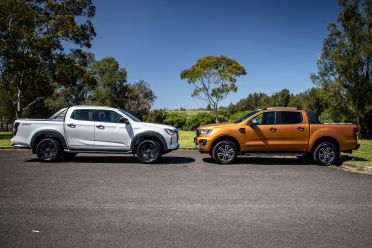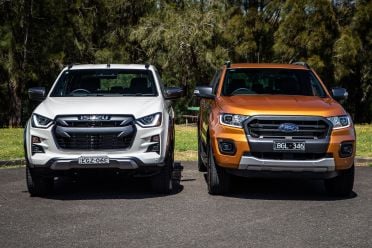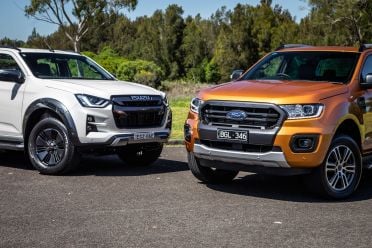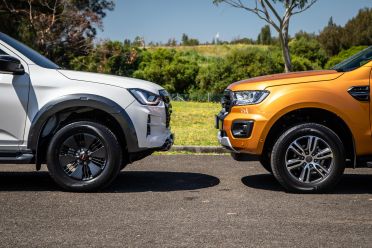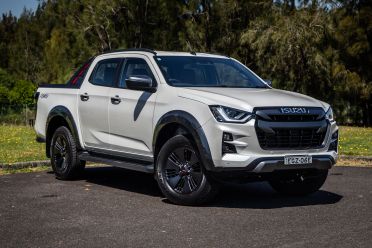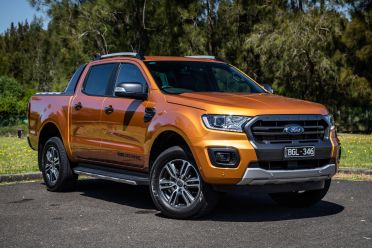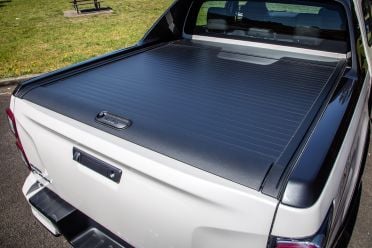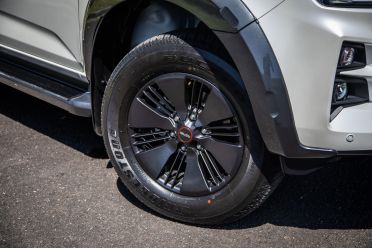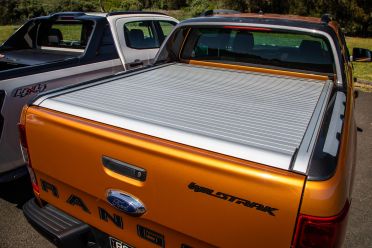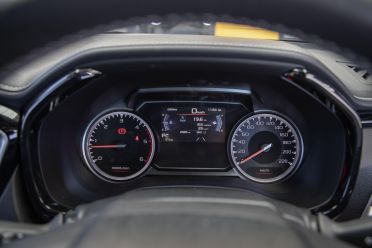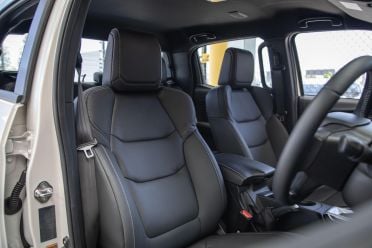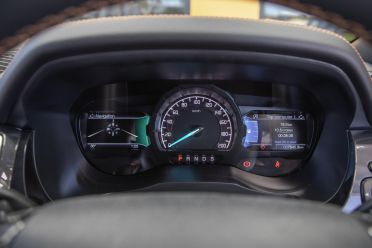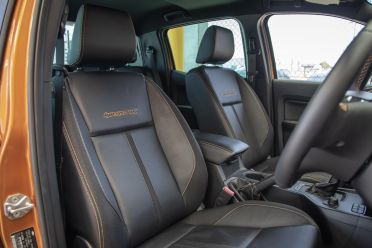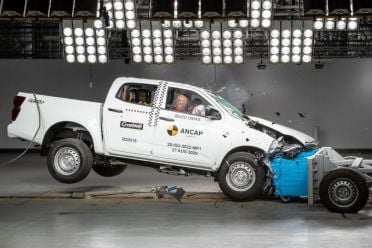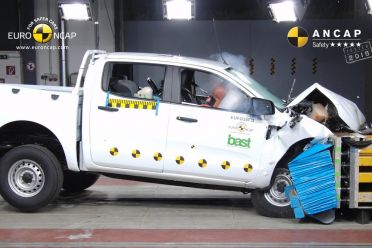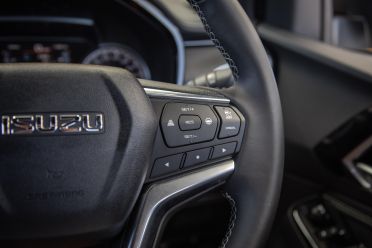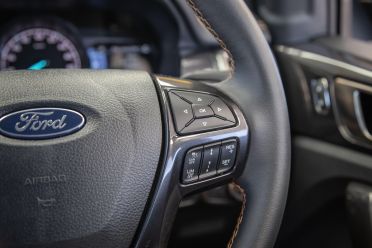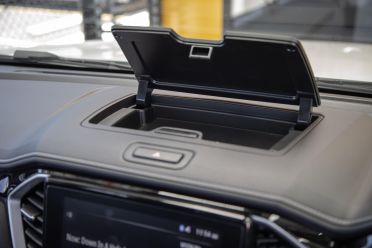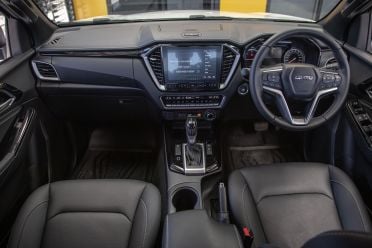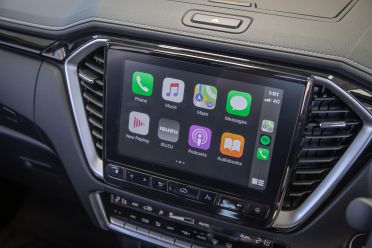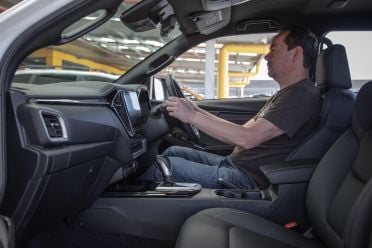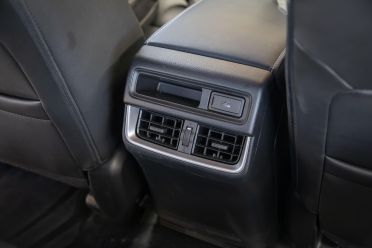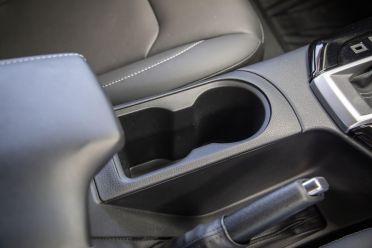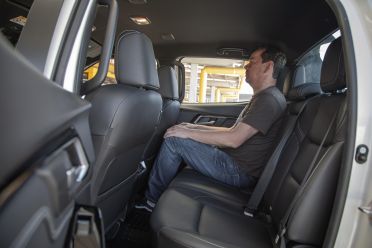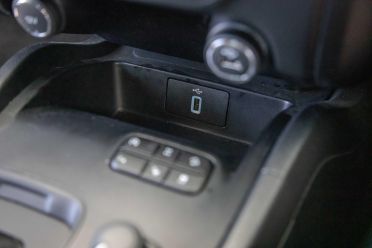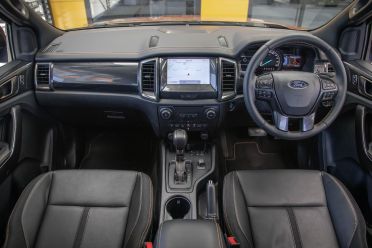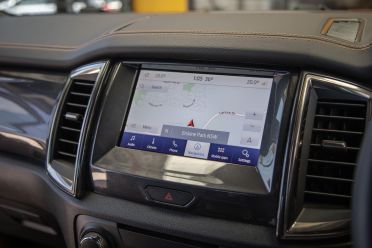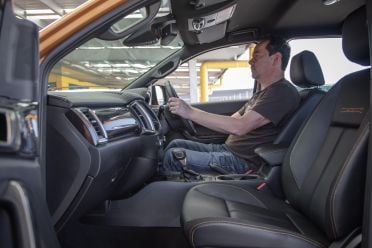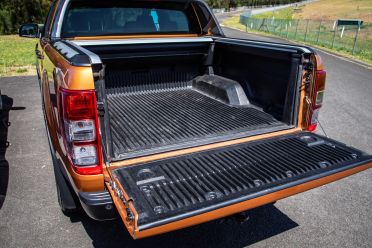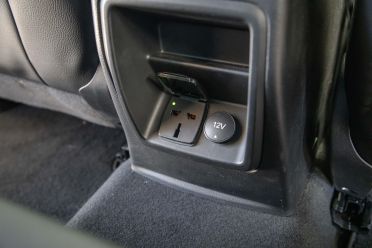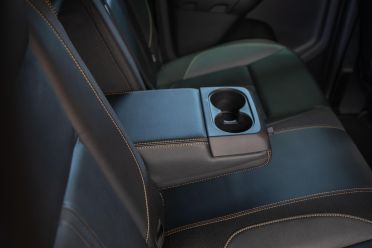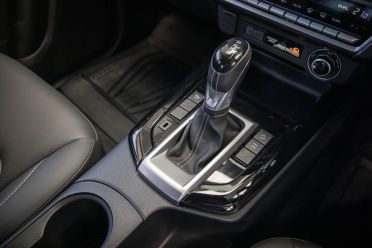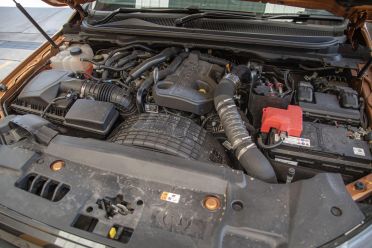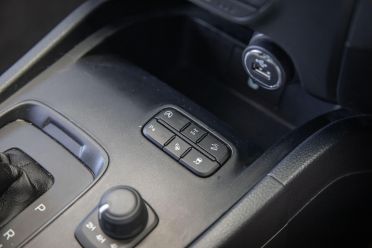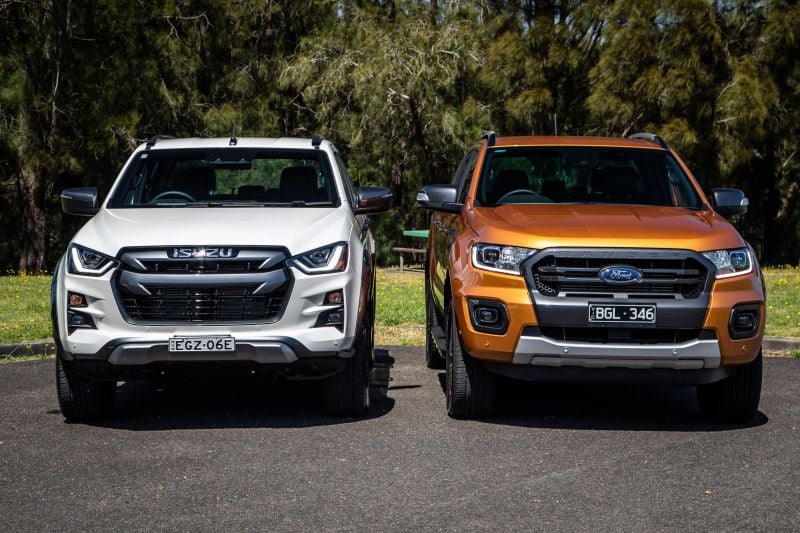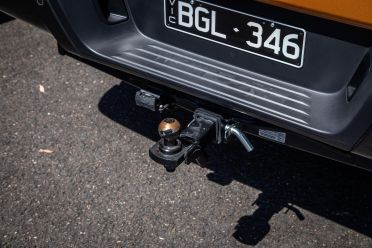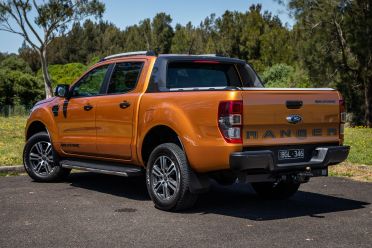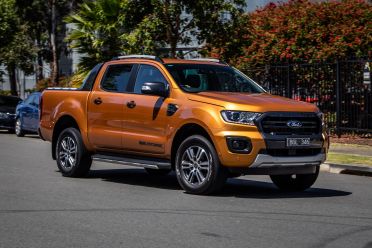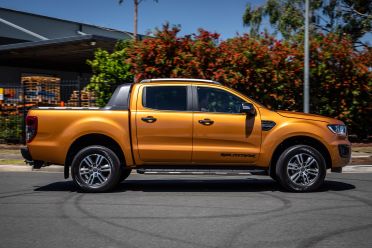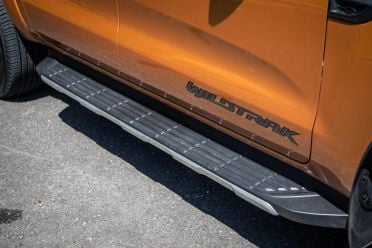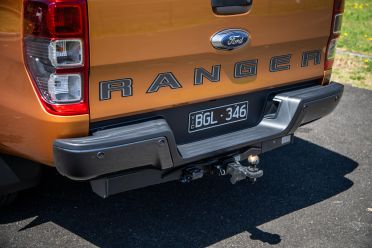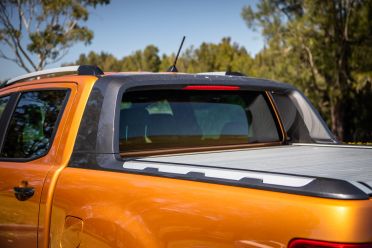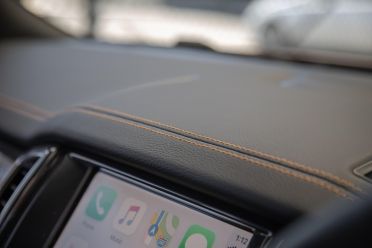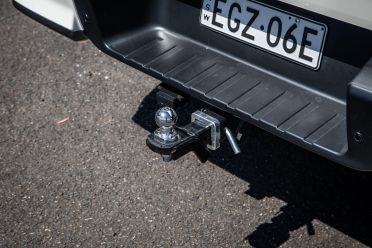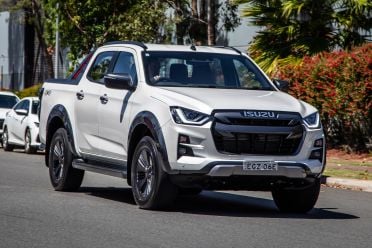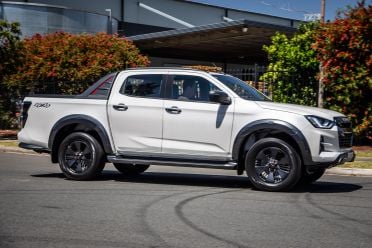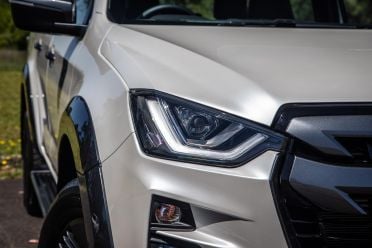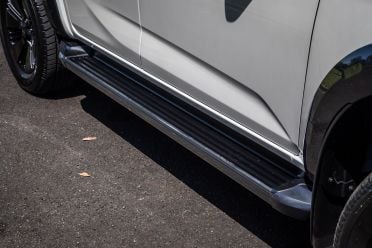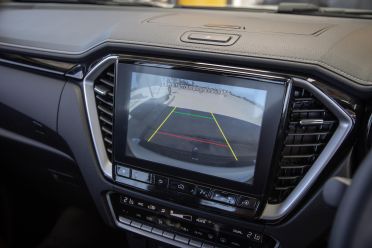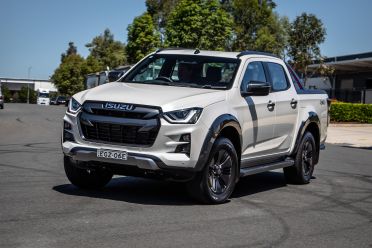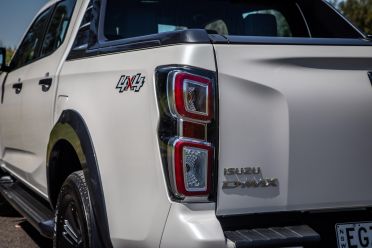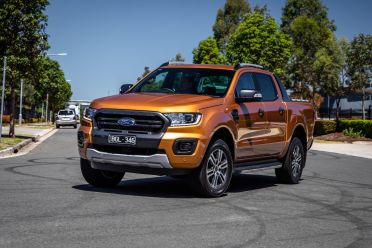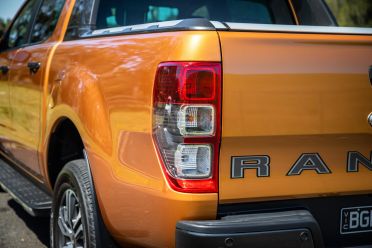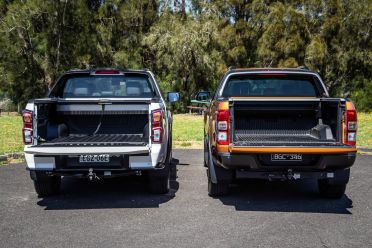Surprise! Just kidding. Pitching the bold, new and thus far critically impressive Isuzu D-Max in flagship X-Terrain guise against a top-selling Ranger or HiLux of similar stature, is probably the most predictable yet compelling comparison one could imagine.
And our Ranger Wildtrack 2.0 Bi-Turbo example is not only the most contemporary and well-rounded variant in its range, it’s arguably the best-balanced dual-cab ute out there for work, play and family-friendliness.
No HiLux? We did try to make this an all-in three-way stoush but accessing one in these ‘unprecedented times’ of testing proved impossible. Indeed, our Ranger is not strictly the absolute latest spec – our test ute didn’t fit Ford Pass remote phone connectivity – as certain COVID-19 Victorian restrictions kept the right spec assessment vehicles firmly on the wrong side of the NSW-Victorian border.
(Ed note: Our ute test featuring the D-Max and Ranger, alongside the Mazda BT-50 and HiLux, is now in the works and will be published soon).
Are X-Terrain and Wildtrak the ideal combatants? Despite the pricing discrepancy (more below), indeed they are. The Ford’s 2.0-litre and 10-speed powertrain is fitter, leaner and smarter than the ageing 3.2 and six-speed combination some might presume is a fairer fight against Isuzu’s revamped 3.0-litre.
And while pricing might suggest the D-Max X-Terrain sits between the Wildtrak and the XLT one grade down, our two test subjects are similarly equipped – right down to seat trim – and similarly positioned in their respective ranges to target the same buyer. Those body add-ons are another giveaway of that.
This leaves pricing and judgement of value-for-money all to play for in a fair and straight fight between the newcomer that scored an impressive 8.4/10 rating in singular review and the popular stalwart benchmark we called an 8.5/10 prospect in its own garage review. That’s pretty close given one is brand-spankers while the other is nudging almost a decade around the traps, albeit in a constantly evolving form.
How much?
Simple question, a slightly more complex answer.
The X-Terrain lists for $62,900 before on-road costs. Meanwhile the Wildtrak’s price is $65,790 before on-roads. The flagship Isuzu is actually priced closer to the lower-grade Ranger XLT ($60,940) or Ranger FX4 ($63,040), but it’s the pair tested here that arguably line up best.
However, these prices are not the ones buyers should be watching. That’s because the D-Max X-Terrain effectively launched out of the blocks with a compelling $58,990 drive-away price – which is what you can actually expect to pay in the real world.
Conversely, Ford’s current offer on Ranger Wildtrak is $67,490 drive away with a $1000 contribution to ABN holders under finance. That’s a real-world divide of $8500 in Isuzu’s favour, for private purchases. Not insubstantial.
However, when last we looked there was also a five-month wait on the D-Max X-Terrain. If you want one you’ll likely need patience, and it’s shrewd gamesmanship on Isuzu’s part for continuing its sharp offer in perpetuity.
Ford for its own part doesn’t seem interested in closing the price gap, and given Ranger spent a recent sales month as the biggest-selling nameplate in Oz – quite the accolade given range maturity – why would it? You can buy your Wildtrak, or any number of price-point Ranger substitutes, right now (with an FX4 Max joining ranks in December). Touche.
| Ford Ranger Wildtrak | Isuzu D-Max X-Terrain | |
|---|---|---|
| List price | $65,790 | $62,900 |
| Drive-away offer | $67,490 | $58,990 |
What do you get?
Both competitors fit 18-inch alloy wheels with identically sized 265/60 Bridgestone Dueler H/T tyres, bi-LED headlights, auto high-beam, side steps, a reversing camera, front and rear parking sensors, rain-sensing wipers, keyless go, and remote start (though our pre-update Wildtrak on test did omit the latest FordPass feature). The Isuzu also has nifty proximity-sensing auto locking/unlocking, too.
Of our test machines, the Wildtrak exclusively features a powered roll top cover for the tray and counterweighted tailgate for easy opening, whereas the X-Terrain assembly is manually operated and has a regular tailgate. Each offers specific visual features though the Isuzu exclusively fits flared arches in flagship form as a key visual upgrade.
Inside, both have leather trim with seat heating, leather-trimmed multifunction steering wheels, dual-zone climate control, radar cruise control, entry handles on the pillars, a one-touch driver’s window, and electric seat adjustment. Instrumentation-wise, the Ford features dual TFT screens whereas the Isuzu fits a single screen. Both utes offer hands-free parking assist.
Infotainment-wise, the Isuzu’s 9.0-inch touchscreen format trumps the Ford’s 8.0-inch unit and offers wireless Apple CarPlay against the Ford’s more common wired format, with both fitting wired Android Auto. Each offers proprietary sat-nav, Bluetooth phone and audio streaming, and DAB+.
They’re very close. Perhaps the Ford has the edge with its extra tray addenda, to which the Isuzu counters with a bit more infotainment bling. Neither steals the lead when it comes fulsome dual-cab ute features. But remember the pricing…
Some key features:
| Ford Ranger Wildtrak | Isuzu D-Max X-Terrain | |
|---|---|---|
| Wheels | 18-inch | 18-inch |
| Tyres | 265/60 Bridgestone Dueler H/T | 265/60 Bridgestone Dueler H/T |
| Tonneau cover | Hard top, powered | Hard top, manual |
| Headlights | LED | LED |
| Touchscreen | 8.0-inch | 9.0-inch |
| Sat–nav | Yes | Yes |
| AppleCarPlay and Android Auto | Yes | Yes (CarPlay is wireless) |
| Digital radio | Yes | Yes |
| Seats | Leather, heated front | Leather, heated front |
Are they safe?
Much song and dance has been performed over the lofty level of safety Isuzu (and its Mazda BT-50 twin) brings to the traditionally tardy commercial ute landscape.
As we’ve reported prior in our twin test against the Amarok, it’s arguably the safest dual-cab out there right now – it scored fractionally better than BT-50 for vulnerable road user impact protection – and the Isuzu-Mazda pair are the only utes to have been assessed by ANCAP’s latest 2020 testing, each scoring five stars.
The Wildtrak also comes with a five-star ANCAP rating, carried through from older pre-AEB 2015 assessment. As covered in our single garage review, the Ranger has since been updated to move with the times by subsequently fitting autonomous emergency braking with pedestrian detection, lane-keeping assist, and the aforementioned adaptive cruise control.
However, the Ranger might not get a five-star ANCAP score today. Why? It fits six airbags, whereas the Isuzu is equipped with eight, including a driver’s knee and, crucially, a centre airbag between the front occupants now encouraged by ANCAP for five-star assessment.
Each matches one another in AEB, forward-collision warning, lane-keeping and departure warning, traffic sign recognition, and rear-cross traffic monitoring, though the Ford lacks blind-spot monitoring as fitted to the Isuzu.
The newcomer D-Max X-Terrain gets the nod here.
What are they like inside?
Isuzu:
Against its predecessor, the D-Max cabin is a revolution. That’s more enthusiasm than I had for the new BT-50 twin’s very similar if not quite identical interior, but then again the Isuzu had a much lower base to leap from than what the Mazda does – with the quality in stablemates such as 3s and CX-9s. The X-Terrain’s cabin is not merely good, it fits the tough truck theme to a tee.
Against the Ranger, it has fresher ambience with nicer presentation though, of course, much of that effect is because it’s measurably newer. Premium? By dual-cab ute measures it is, though Audi’s interior design department need not lose much sleep…
The X-Terrain is nicely balanced in that hardy plastics remain in the predictable areas yet some effort has gone in making things plush and tactile where it counts: the wheel trim, the touch points, the grade of seating leather.
The front seat appearance and shapeliness is excellent, sporty in theme if impressively supportive and comfortable. They lend themselves nicely to long trips or all-dayers in the saddle despite the fact there’s no lumber adjustment as found in the Ranger. Nice double stitching, too.
The central stack is a mixed bag, with nice buttons for the climate control and ventilation array, but cheap wobbly-surfaced shortcut buttons for infotainment control. It has a lower dash fascia and perhaps a little better forward vision than the Ford, and telescopic adjustment of the steering wheel – not featured in its predecessor – improves ergonomics in a big way.
The instruments are rudimentary but offer clear information, but why the skimpy half-sized driver’s screen? Meanwhile, the large infotainment screen is decent and its user interface not difficult to negotiate, though the split-screen skin mightn’t be to all user tastes. It plays second fiddle to its competitor for reversing camera quality – grainy, with static guidelines – but of the two utes on show it has the richest audio quality. Also, why no volume knob?
It trumps the Ford in couple of areas such as the pop-out cup-holders in the dash, dual gloveboxes and practical dash-top storage bin, but the console cup-holders, sans securing teeth, are too deep to accommodate small cups lest you want to wear hot coffee in your lap. Lots of storage, then, including provision for bottles in the door cards.
The Isuzu’s second row is quite impressive: the high-set seat bases offer kids excellent viewing inside and out, the seat profile has a relaxed back rake for adult comfort, and knee room is quite generous. Rear air vents and device power are catered for, there’s a handy grocery bag hook, and even a surround-sound ceiling-mounted speaker. There’s ‘storage’ under the seat, if that’s what you call a modest bit between the seat base and unlined steel floor plate.
The lockable roller-blind cover is handy though it’s stiff and arduous to open or close (via a handy strap). The tub is an almost square 1570mm x 1530mm, of moderate 490mm depth, and 1122mm between the arches but, without as much as a 12-volt outlet, a bit slim on features.
Ford:
The Ranger’s evergreen cabin space stacks up surprisingly well and is showing its age gracefully. It’s certainly no downgrade against the Isuzu and, indeed, many an owner will prefer the Ford’s honest ‘classic’ vibe that’s techy enough without feeling overly flashy.
It feels roomy and, well, ‘deep’ as the dash rises higher than Isuzu and cocoons occupants more: a pro or con depending on personal taste. The instrumentation is clear and its dual screens still charm. And like its rival it balances plushness and hardy plastics deftly with a softness and suppleness to the touch points something akin to a ‘favourite old lounge chair’ vibe.
Speaking of which, I was expecting a huge difference in front seating, but the variation in support and comfort is only slight at best between the competitors. That said, Ford’s leather isn’t quite as supple as the Isuzu’s.
From the superior button/knob quality to neat dash stitching, the Ranger’s cabin still stacks up nicely and almost timelessly – testament to it is that Ford can still charge as much as it does for the flagship Wildtrak so well into its lifecycle.
That its maker constantly evolved its ute throughout the past decade in areas such as infotainment is key to today’s ongoing popularity. Its 8.0-inch format is smaller than the Isuzu’s, but the Sync 3 format is clear, friendly, intuitive and shines in areas actually more important and useful to the user than sheer flashiness.
It fits a huge console bin, ample storage and, while lacking Isuzu’s pop-out cupholder trick has a spring-loaded design in the console that works well.
The one big surprise is that the Ranger’s second row feels more cramped than the D-Max’s. The rear seat shape isn’t quite as comfy, knee room is more constrictive, and there are no rear air vents as fitted to the Isuzu (though you do a get 230V three-pin outlet and a 12V).
The Ranger’s tub is a little shorter (1549mm) but a little wider (1560mm) and deeper (511mm) than the Isuzu’s, and there’s a fraction more clearance between the wheel housings (1139mm). But the load height seems the same and the sheer ease-of-use of the powered roll top and counterweighted tailgate brings a more premium vibe to the business end of the package.
What’s under the bonnets?
That the Isuzu fits a reengineered ‘4JJ3-TCX’ version of its familiar 3.0-litre diesel is well documented. It outputs 140kW at 3600rpm and 450Nm from 1600rpm and is backed by a choice of six-speed manual or, as tested here, conventional automatic.
Isuzu devotees have long been drawn to D-Max for its big diesel, but its outputs are – on paper at least – quite modest for its capacity. Whether the engine is lazy as a negative or potentially unstressed as a positive is a decision for personal interpretation.
Similarly, the dominant 157kW at 3750rpm and 500Nm at 1750rpm from the Ranger’s 2.0-litre Bi-Turbo diesel could be perceived as being healthily efficient as a positive, or perhaps hard-worked in an opposite spin. It’s backed by a ten-speed auto.
Of course, you can still have your Wildtrak for the time being in older 3.2-litre 147kW and 470Nm form with six-speed auto that still outswings the Isuzu on paper… if you have concerns about how hard the Bi-Turbo version might get worked towing and lugging. Speaking of which, braked towing is 3500kg either way, while payload is 954kg for the Ranger and 970kg for the D-Max.
Ford claims 7.4L/100km combined diesel consumption for its 2.0-litre ute, with the Isuzu a thirstier 8.0L/100km for its 3.0-litre contender, with 80- and 76-litre tanks fitted respectively.
Right here, things get a little more interesting. In identical mixed urban-highway driving, in convoy, the larger-capacity D-Max bucked the form guide and proved to be markedly more frugal, its impressive 8.0L/100km figure – exactly its claim – beating out the Ranger’s 9.4L/100km as tested.
Each adopts double wishbone front and leaf rear suspension, electric-power steering systems and identical 800mm wading capabilities. Both utes allow switching between 2WD and 4WD-high mode at up to 100km/h and fit rear differential locking functionality, though only the Ranger allows the rear lock activation in both high and low 4WD modes.
| Ford Ranger Wildtrak | Isuzu D-Max X-Terrain | |
|---|---|---|
| Displacement | 2.0 | 3.0 |
| Cylinders | 4 | 4 |
| Power | 157kW @ 3750rpm | 140kW @ 3600rpm |
| Torque | 500Nm @ 1750 – 2000rpm | 450Nm @ 1600 – 2600rpm |
| Transmission | 10-speed auto | 6-speed auto |
| Towing capacity | 3.5 tonnes | 3.5 tonnes |
| Claimed fuel economy | 7.4L/100km | 8.0L/100km |
How do they drive?
The theme for assessment here is on-road seat-of-the-pants performance, general comfort and drivability as a lifestyle ute and daily driver. We’ll reserve load-lugging, towing and off-roading for dedicated testing in future.
Ford:
I’ve spent a lot of seat time in dual-cab Rangers over the years and our tester is as surprise-free as it is (and remains) impressive. It’s marvellous how much nicer and pokier this Bi-Turbo powertrain is over its 3.2-litre five-cylinder-motivated twin, and its quiet and impressively refined nature doesn’t hint at how hard the engine may or not be working even driven with vigour.
Consumption, though, suggests it’s not lolling about even during leisurely driving.
There’s nice middling weight to the steering that’s easy on the arms at low speeds, which is good for what feels like such a big unit. If there’s value in sheer mass of metal, glass and rubber, it returns it in how it feels on road.
The engine does a fine job of swelling torque upwards in tandem with rpm though its sweet spot is in a narrow operating band. Indeed, the ten-speed transmission does a beaut job of plucking the engine’s goodness by slickly rifling through ratios, but the upshot is a character that seems more tailored to refinement than sheer toey gutsiness.
The Aussie-developed Ranger with its tuned-for-Oz ride almost never fails to feel like soothing balm in local conditions after seating time in most competitors. It just removes and isolates noise and vibration confidently, be it around the ‘burbs or on the open road. Across our test loop’s speed bumps, the rear axle is evidently set softer than the front end, cushioning the impact more confidently than the Isuzu’s rear if in a slightly less-settled manner.
The Ranger proves you can tune in suspension suppleness without compromising payload capacity. But, again, the Ford feels larger and a little more encumbered by its mass, which can get a bit of the wobble on across undulations and where a decent amount of wheel articulation is called for.
Isuzu:
There’s clearly more refinement at play over the old version of the 3.0-litre diesel and it is quieter though, in engine sonics and body noise suppression, it’s not the whisperer the Ranger is. But the big surprise is the size if its swing.
The D-Max is patently punchier than the Ranger. It grabs its peak torque harder and earlier and hangs on to a fair chunk of it through a broader rpm sweep. The six-speed auto, too, does a commendable job of holding and riding the torque wave and, thus, doesn’t lack for having four fewer ratios than the Ford.
You can park the stats at pub banter, because by the seat of the pants the Isuzu feels the swifter of the two. And with more gratifying instant punch while it’s at it. Remember, too, the D-Max also proved quite a bit more frugal as well.
The D-Max’s shorter size, lower dash and more eager heartbeat conspire to a lighter and leaner feeling ute on the go than the Ranger. In other words, it actually feels ‘more powerful’ despite what numbers otherwise state.
The newcomer has already demonstrated it’s superior in every way to its forebear, but it’s also been praised in isolation for a ride quality expected to match that of the segment’s best: that is, the Ranger. And while it’s good – and strangely a little better than the identically spec’d BT-50 I reviewed recently – it remains more rigid across the rear end than the supple Wildtrak when sampled back to back across the same set of speed humps.
That said, it settles a touch quicker and returns less traction-compromising bounce.
I’d still peg the X-Terrain as one of the dual-cab universe’s better ride and handling packages. Indeed, where it lacks against the Ford in ride comfort it makes up for with crisper control and keener response to driver input. It’s a really bloody decent thing.
This generation is a quantum leap better and nicer on road than its predecessor and for a good many buyers it’s easily enough of a lunge into proper lifestyle ute territory, if not so much that it comes across as too ‘soft’. For instance, it’s impressively quiet on the highway, be it hot mix or coarse chip, and feels genuinely upmarket doing so… it just isn’t quite as pampering as the Ranger.
Where the Wildtrak is little more ‘luxury’ dual-cab, the X-Terrain is a little more ‘sport’ dual-cab. Not only does the Isuzu fit the bill it’s pitching with that appearance package, the more athletic vibe is going to appeal more favourably to a good many buyer tastes.
| Ford Ranger Wildtrak | Isuzu D-Max X-Terrain | |
|---|---|---|
| Vehicle weight | 2246kg | 2130kg |
| Payload | 954kg | 970kg |
| GVM | 3200kg | 3100kg |
| GCM | 6000kg | 5950kg |
| Length | 5446mm | 5280mm |
| Width | 1867mm | 1880mm |
| Height | 1848mm | 1810mm |
| Wheelbase | 3220mm | 3125mm |
| Ground clearance | 237mm | 240mm |
Cost of ownership
The D-Max is covered by six years or 150,000kms of warranty, with seven years of roadside assist and seven years of capped-priced servicing. Its 12-month/15,000km servicing intervals vary between $299 and $609 per visit and average out across five years to $443 per year.
Meanwhile, the Ranger is covered by five years of warranty with unlimited-kilometre usage. Like the Isuzu, servicing is every 12 months or 15,000kms, at $299 for the first four visits and $375 for the fifth (plus $115 for a brake fluid change in the third service). At a $337.20 per-year average over five years, the Ford is quite a bit cheaper to service.
CarExpert’s Pick
It takes the comparative presence of an all-new generation of ute as good and deservingly popular as the 2021 D-Max X-Terrain to really appreciate how competitive the Ranger Wildtrak has remained until today. That the newcomer didn’t pull a decisive victory over the likeable stalwart is true testament to the effort Ford continues to inject into its golden child.
In fact, we hadn’t anticipated these two seemingly quite different competitors would be so level pegged in all-round goodness: the Isuzu for all-round nicety and fitness that’s long been Ranger’s wheelhouse, the Wildtrak remaining downright contemporary where it really counts and where the X-Terrain should’ve dominated in its youthfulness.
They’re both bloody outstanding. Each has the edge in certain areas that lean a little closer to certain buyer preferences though, realistically, if you have your heart set on either there’s no loss in sight whichever you choose.
However, we’ve given the Isuzu the win here, if by a nose. Why? Because in powertrain alone the D-Max punches above what the form guide suggests in direct comparison to what the Ranger delivers in practice. The Ford should feel fitter than the Isuzu, and ought to be more frugal at the pump, but it’s not.
That the D-Max doesn’t drop the ball anywhere – even in comparative ride quality – seals the victory, albeit by quite a slim margin.
Want more? See our previous Ranger and D-Max videos
Photos by Sam Rawlings.




